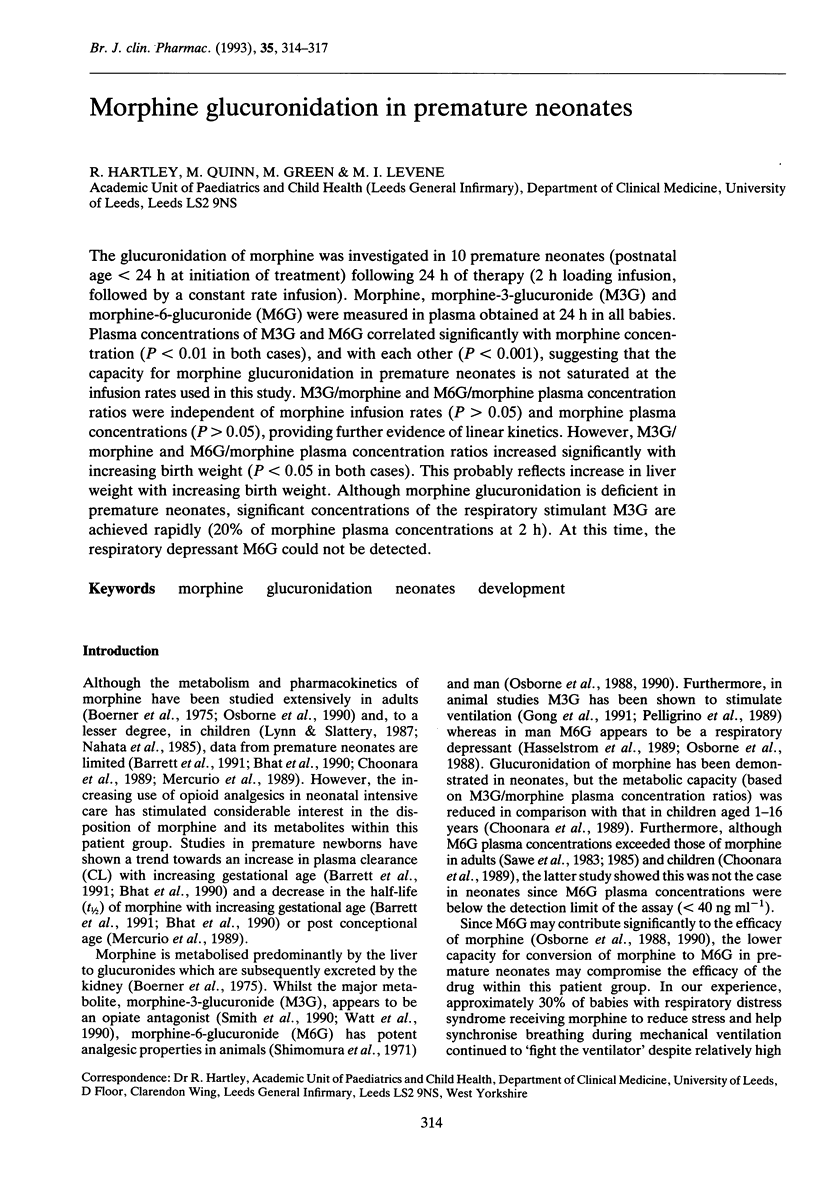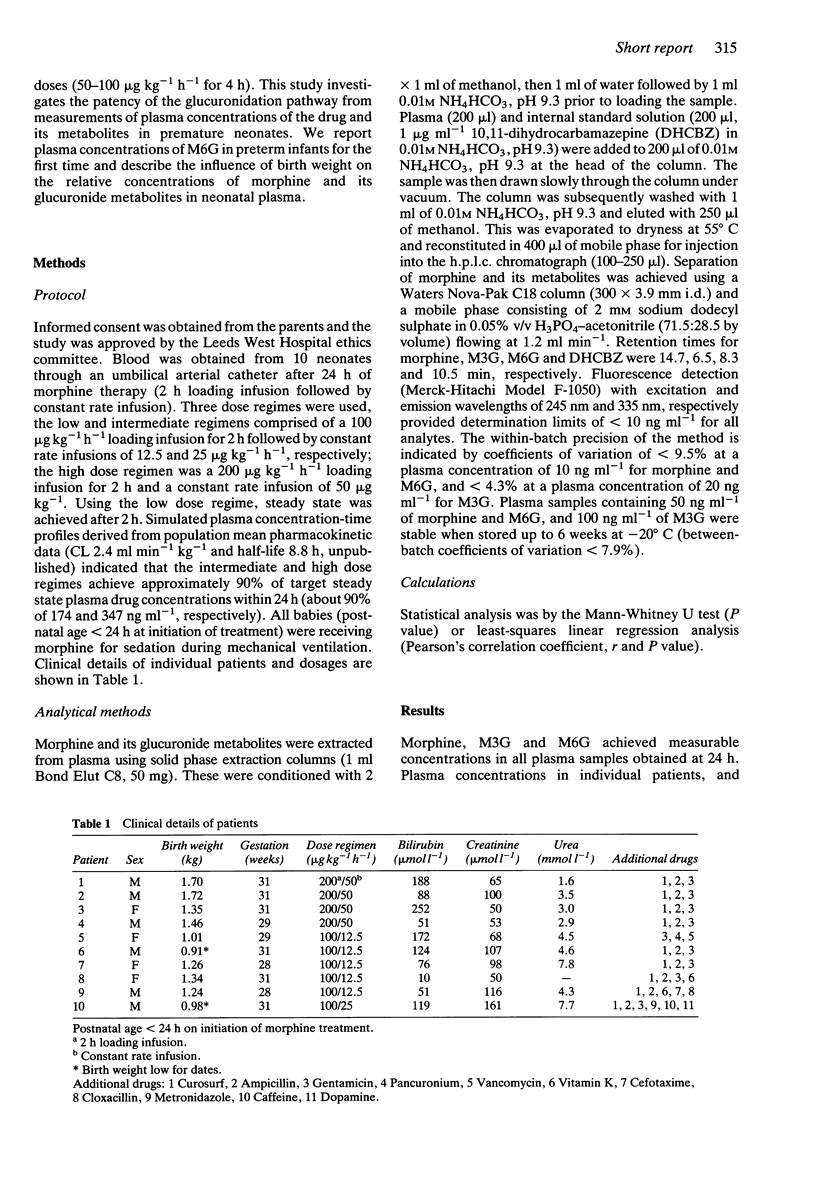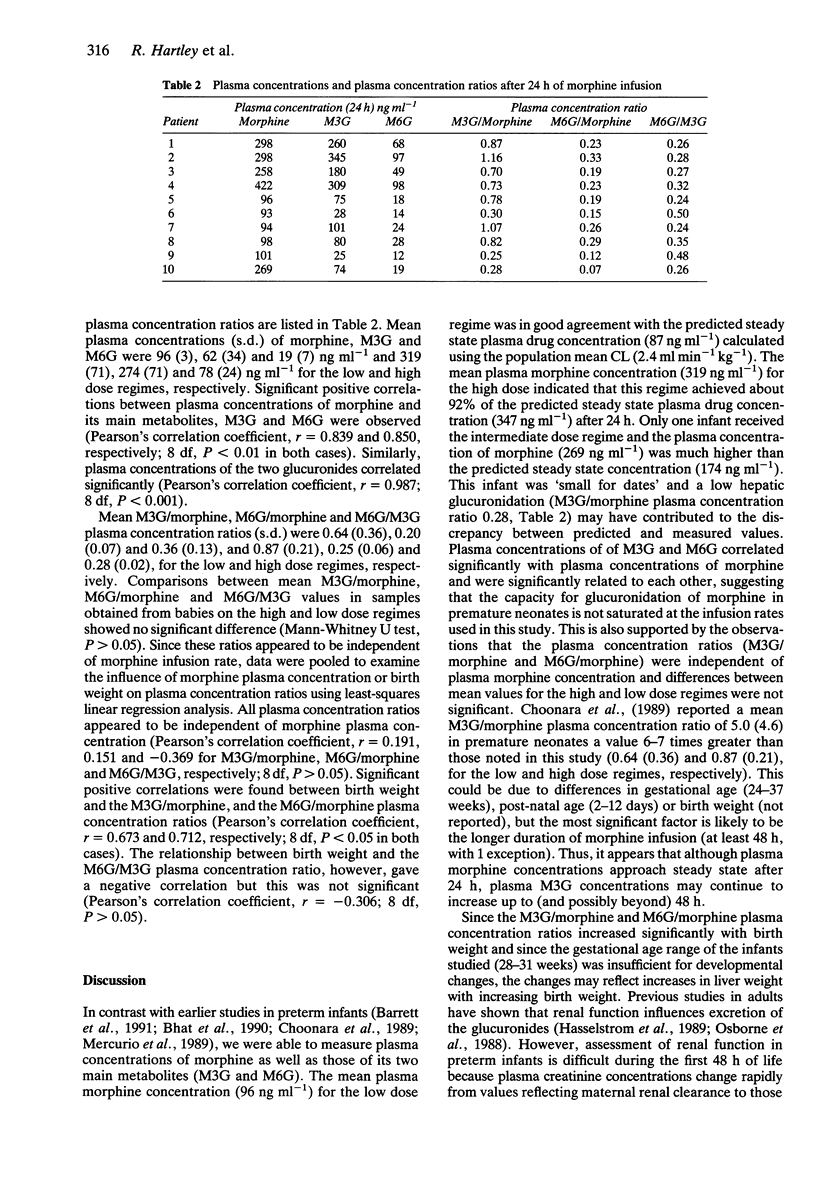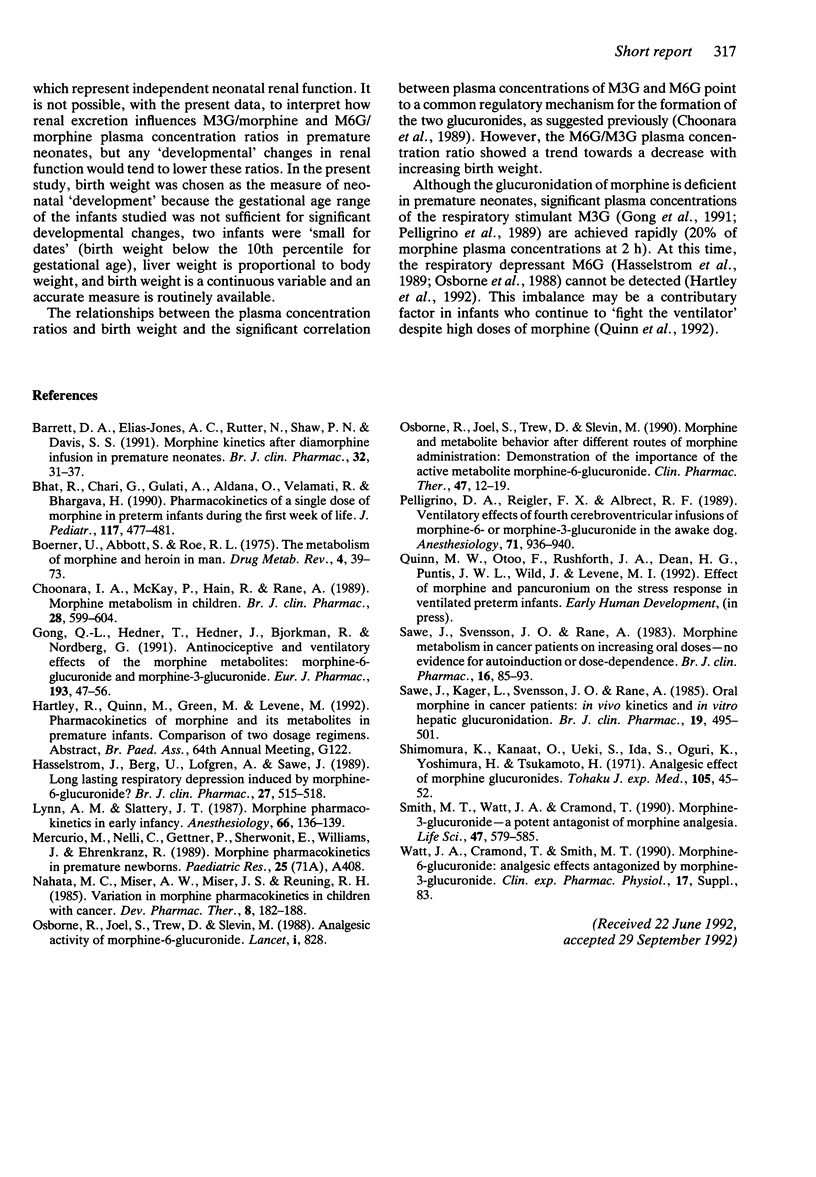Abstract
The glucuronidation of morphine was investigated in 10 premature neonates (postnatal age < 24 h at initiation of treatment) following 24 h of therapy (2 h loading infusion, followed by a constant rate infusion). Morphine, morphine-3-glucuronide (M3G) and morphine-6-glucuronide (M6G) were measured in plasma obtained at 24 h in all babies. Plasma concentrations of M3G and M6G correlated significantly with morphine concentration (P < 0.01 in both cases), and with each other (P < 0.001), suggesting that the capacity for morphine glucuronidation in premature neonates is not saturated at the infusion rates used in this study. M3G/morphine and M6G/morphine plasma concentration ratios were independent of morphine infusion rates (P > 0.05) and morphine plasma concentrations (P > 0.05), providing further evidence of linear kinetics. However, M3G/morphine and M6G/morphine plasma concentration ratios increased significantly with increasing birth weight (P < 0.05 in both cases). This probably reflects increase in liver weight with increasing birth weight. Although morphine glucuronidation is deficient in premature neonates, significant concentrations of the respiratory stimulant M3G are achieved rapidly (20% of morphine plasma concentrations at 2 h). At this time, the respiratory depressant M6G could not be detected.
Full text
PDF



Selected References
These references are in PubMed. This may not be the complete list of references from this article.
- Barrett D. A., Elias-Jones A. C., Rutter N., Shaw P. N., Davis S. S. Morphine kinetics after diamorphine infusion in premature neonates. Br J Clin Pharmacol. 1991 Jul;32(1):31–37. doi: 10.1111/j.1365-2125.1991.tb05609.x. [DOI] [PMC free article] [PubMed] [Google Scholar]
- Bhat R., Chari G., Gulati A., Aldana O., Velamati R., Bhargava H. Pharmacokinetics of a single dose of morphine in preterm infants during the first week of life. J Pediatr. 1990 Sep;117(3):477–481. doi: 10.1016/s0022-3476(05)81102-3. [DOI] [PubMed] [Google Scholar]
- Boerner U. The metabolism of morphine and heroin in man. Drug Metab Rev. 1975;4(1):39–73. doi: 10.3109/03602537508993748. [DOI] [PubMed] [Google Scholar]
- Choonara I. A., McKay P., Hain R., Rane A. Morphine metabolism in children. Br J Clin Pharmacol. 1989 Nov;28(5):599–604. doi: 10.1111/j.1365-2125.1989.tb03548.x. [DOI] [PMC free article] [PubMed] [Google Scholar]
- Gong Q. L., Hedner T., Hedner J., Björkman R., Nordberg G. Antinociceptive and ventilatory effects of the morphine metabolites: morphine-6-glucuronide and morphine-3-glucuronide. Eur J Pharmacol. 1991 Jan 25;193(1):47–56. doi: 10.1016/0014-2999(91)90199-z. [DOI] [PubMed] [Google Scholar]
- Hasselström J., Berg U., Löfgren A., Säwe J. Long lasting respiratory depression induced by morphine-6-glucuronide? Br J Clin Pharmacol. 1989 Apr;27(4):515–518. doi: 10.1111/j.1365-2125.1989.tb05401.x. [DOI] [PMC free article] [PubMed] [Google Scholar]
- Lynn A. M., Slattery J. T. Morphine pharmacokinetics in early infancy. Anesthesiology. 1987 Feb;66(2):136–139. doi: 10.1097/00000542-198702000-00005. [DOI] [PubMed] [Google Scholar]
- Nahata M. C., Miser A. W., Miser J. S., Reuning R. H. Variation in morphine pharmacokinetics in children with cancer. Dev Pharmacol Ther. 1985;8(3):182–188. doi: 10.1159/000457035. [DOI] [PubMed] [Google Scholar]
- Osborne R., Joel S., Trew D., Slevin M. Analgesic activity of morphine-6-glucuronide. Lancet. 1988 Apr 9;1(8589):828–828. doi: 10.1016/s0140-6736(88)91691-1. [DOI] [PubMed] [Google Scholar]
- Osborne R., Joel S., Trew D., Slevin M. Morphine and metabolite behavior after different routes of morphine administration: demonstration of the importance of the active metabolite morphine-6-glucuronide. Clin Pharmacol Ther. 1990 Jan;47(1):12–19. doi: 10.1038/clpt.1990.2. [DOI] [PubMed] [Google Scholar]
- Pelligrino D. A., Riegler F. X., Albrecht R. F. Ventilatory effects of fourth cerebroventricular infusions of morphine-6- or morphine-3-glucuronide in the awake dog. Anesthesiology. 1989 Dec;71(6):936–940. doi: 10.1097/00000542-198912000-00018. [DOI] [PubMed] [Google Scholar]
- Shimomura K., Kamata O., Ueki S., Ida S., Oguri K. Analgesic effect of morphine glucuronides. Tohoku J Exp Med. 1971 Sep;105(1):45–52. doi: 10.1620/tjem.105.45. [DOI] [PubMed] [Google Scholar]
- Smith M. T., Watt J. A., Cramond T. Morphine-3-glucuronide--a potent antagonist of morphine analgesia. Life Sci. 1990;47(6):579–585. doi: 10.1016/0024-3205(90)90619-3. [DOI] [PubMed] [Google Scholar]
- Säwe J., Kager L., Svensson Eng J. O., Rane A. Oral morphine in cancer patients: in vivo kinetics and in vitro hepatic glucuronidation. Br J Clin Pharmacol. 1985 Apr;19(4):495–501. doi: 10.1111/j.1365-2125.1985.tb02675.x. [DOI] [PMC free article] [PubMed] [Google Scholar]
- Säwe J., Svensson J. O., Rane A. Morphine metabolism in cancer patients on increasing oral doses--no evidence for autoinduction or dose-dependence. Br J Clin Pharmacol. 1983 Jul;16(1):85–93. doi: 10.1111/j.1365-2125.1983.tb02148.x. [DOI] [PMC free article] [PubMed] [Google Scholar]


